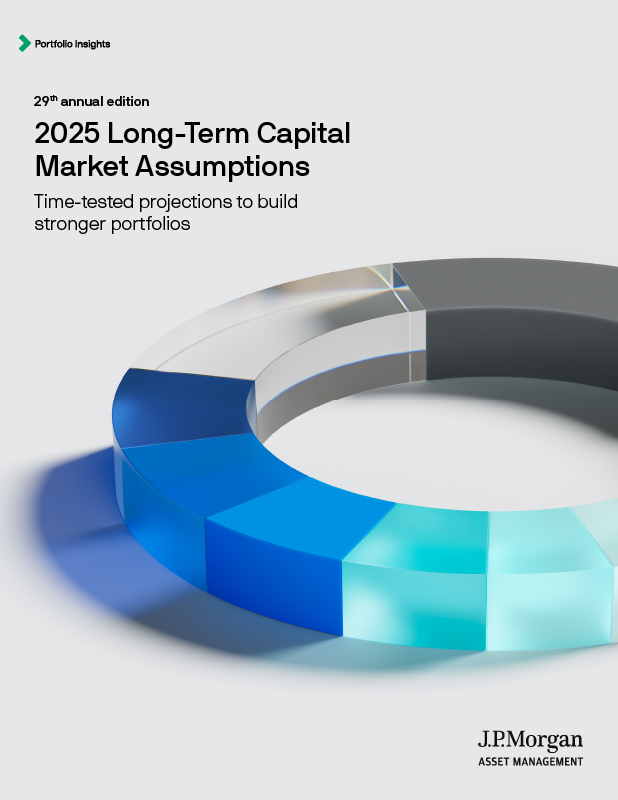Projections for stronger portfolios
Our assumptions see attractive real return potential, while differentiation across assets provides a richer hunting ground for active investors.
Matrices
Our expectations for returns, volatilities and correlations. Use our interactive version to download the excel in your chosen currency.
The assumptions are not designed to inform short-term tactical allocation decisions. Our assumptions are carefully built and calibrated to aid investors with strategic asset allocation or policy-level decisions over a 10- to 15-year investment horizon.
Download Excel and PDF matrices by currency
Assumptions
Examine our return projections by major asset class and the thinking behind the numbers.
Long-Term Capital Market Assumptions: Methodology Handbook
A companion volume to dive deeper into our LTCMAs’ building blocks
- Executive Summary
- Macroeconomic
- Public markets
- Private markets
- Volatility, Correlation and Portfolio Implications
EXECUTIVE SUMMARY
Higher starting points, healthier foundations
Key points
We publish the 29th edition of our Long-Term Capital Market Assumptions (LTCMAs) as a new economic era comes into focus. Gone is the low investment, low growth and low interest rate world of the 2010s. Despite the geopolitical risks that dominate the headlines, under the surface we see a healthier global economy set to deliver higher growth, robust capital investment and higher rates.
Higher policy rates reinforce strong projected bond returns, and higher growth supports corporate earnings and projected equity returns (only modestly lower despite challenging starting valuations). Our long-term return forecast of 6.4% for a USD global 60/40 stock-bond portfolio dips 60 basis points (bps) from last year. Alternatives are now emerging from a period of asset repricing and offer compelling returns and diversification options. Our 2025 LTCMAs explore several themes that we think will shape markets over our forecast horizon:
- Fiscal activism: Austerity is off the agenda as governments have shifted toward fiscal activism. But it matters how public funds are spent. To boost real growth and not merely fuel inflation will require investments that stimulate supply rather than purely stoke demand.
- Economic nationalism: The pandemic highlighted the fragilities in supply chains and infrastructure, spurring economic nationalism (and keeping our estimate of inflation volatility elevated). We note that there is a fine line between pragmatic economic nationalism and overt protectionism.
- Artificial intelligence (AI): Adoption of artificial intelligence has only just begun, but it will likely affect all parts of the economy. We now project a 20 basis point annual boost to developed economies’ growth from AI – potentially a conservative estimate.
Portfolios for a new economic era will need to manage a range of risks. But overall, our 2025 LTCMAs offer an optimistic outlook. As investment levels pick up and rates normalize, we think a healthy – even buoyant – economy will emerge, providing a strong foundation for asset markets.
The post-global financial crisis deleveraging is behind us
Average annual growth in private sector credit and government fixed investment
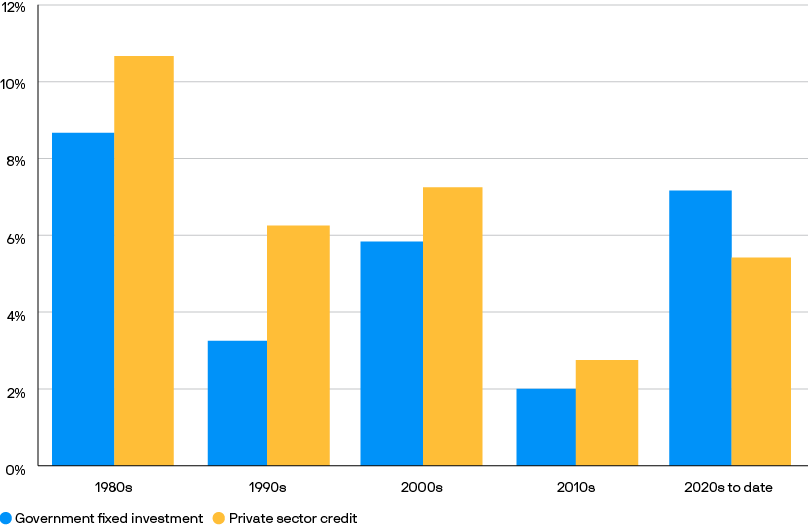
Source: Federal Reserve, LSEG Datastream, J.P. Morgan Asset Management; data as of September 26, 2024.
MACROECONOMIC ASSUMPTIONS
Improved prospects for stronger growth and lower inflation
Key points
- Our developed market growth forecast rises modestly, due to higher capital spending and the impacts of artificial intelligence (AI). Our emerging market growth forecast is broadly stable; slowing Chinese growth offsets gains elsewhere.
- Our inflation forecasts decline slightly, largely because of lower starting points, although long-term forces still leave inflation slightly higher than before the pandemic.
- Accelerating capital spending on AI could boost GDP directly, as well as indirectly via productivity gains; it could also be deflationary in the forecast period’s later years.
- We expect increased investment to combat climate change, and higher defense spending in Europe. These expenditures could boost economic growth but prove mildly inflationary – as could more active fiscal policy.
Capital investment has the largest impact on our 2025 long-term growth forecasts
Contributors to 2025 LTCMA GDP growth forecasts
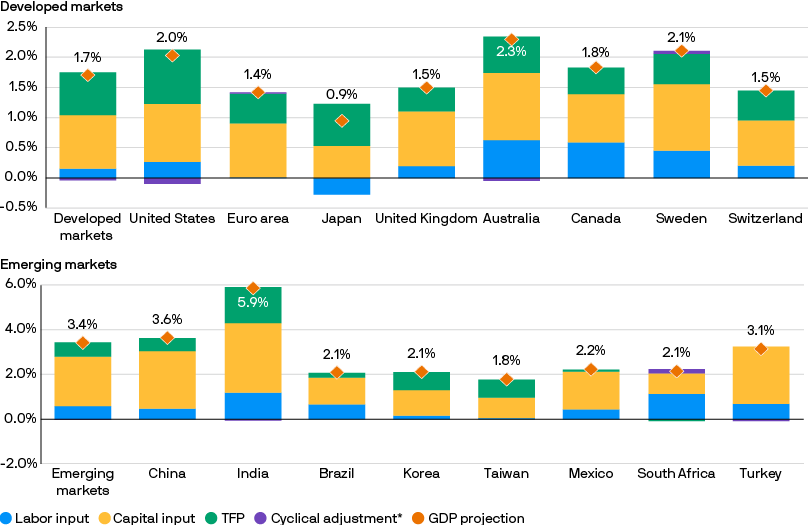
Source: J.P. Morgan Asset Management; data and forecasts as of September 30, 2024. Labor and capital inputs are the growth rates of labor and capital multiplied by their respective shares. Cyclical adjustment is calculated as annualized convergence of current output gap to probability-weighted expected average output gap at the end of the LTCMA forecast horizon. All numbers shown to 1 decimal point.
PUBLIC MARKET ASSUMPTIONS
Higher growth, higher rates – and solid returns
Key points
- We expect investment spending and tech advancements to support public market returns.
- Our higher growth and cash rate forecasts support core fixed income returns, narrower cycle-neutral credit spreads and increased revenue growth expectations for equities.
- Artificial intelligence adoption may support higher revenue growth and margins, especially for U.S. large caps.
- The transition from monetary to fiscal activism suggests steeper curves and higher inflation volatility.
- Cyclical challenges include elevated starting valuations for U.S. large caps and historically tight corporate credit spreads.
- Economic nationalism is another challenge, and key to our FX forecasts. We expect a weaker U.S. dollar, but USD depreciation will be more muted than we forecast last year.
We explore several key themes and their impacts on our asset class returns
Key themes and asset class impacts
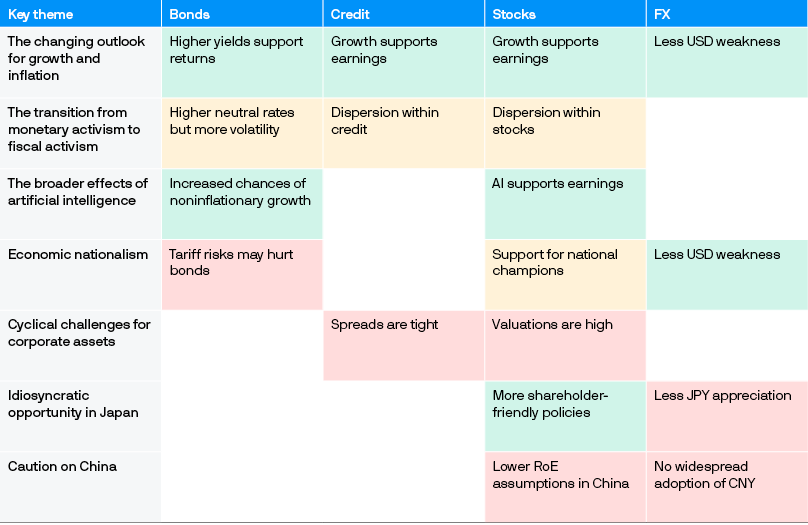
Source: J.P. Morgan Asset Management; data as of September 30, 2024.
PRIVATE MARKETS ASSUMPTIONS
Strong foundations for an era of rising alpha
Key points
- A new economic era is coming into view as powerful forces – higher base rates, rising capital investment, escalating geopolitical tensions and greater inflation volatility – reshape our 2025 return assumptions for private markets.
- In the most rate-sensitive real assets, such as real estate, we see a generational opportunity emerging as valuations re-rate. Other real assets, such as infrastructure, timber and transport, provide stable returns and inflation protection; returns for commodities continue to outpace inflation.
- We maintain a guardedly optimistic outlook for most financial alternatives, including private equity and venture capital, given the rise of AI and greater private sector investment spending. Hedge funds benefit from elevated base rates, which nudge alpha higher.
Manager dispersion in alternatives has been wide historically – and this will likely continue, underscoring the importance of manager selection
Historical annualized returns by manager’s ranking
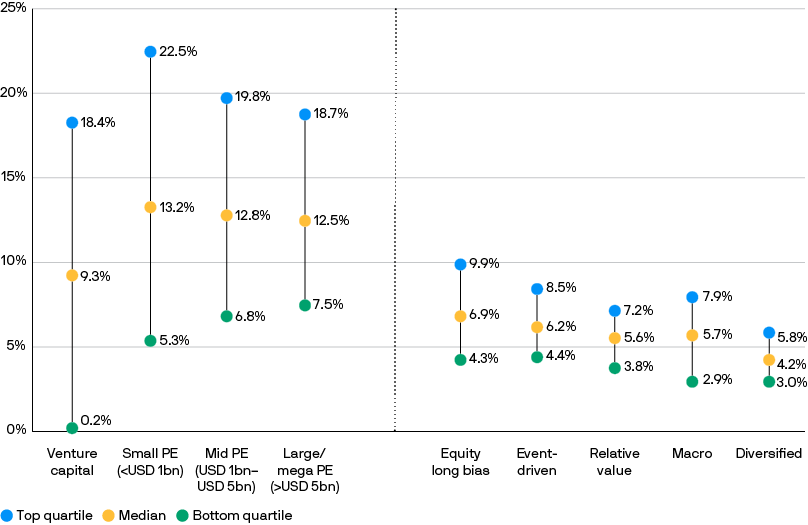
Source: Burgiss Private iQ, HFR, Inc., Morningstar, J.P. Morgan Asset Management; data as of March 31, 2024. Charts internal rate of return for private equity and venture capital; time-weighted returns for other asset classes. Private equity data include buyout and expansion capital funds, and represent vintages from 2006–24. Hedge fund data represent trailing 10-year annualized returns (by strategy type) as of March 31, 2024.
Volatility, Correlation and Portfolio Implications
No time for autopilot: Charting a path to resilient portfolios
Key Points
We make only modest year-over-year changes in our volatility and correlation forecasts. But we also see a wider range of potential outcomes, with significant implications for asset allocation.
Higher growth, strong investment and higher rates provide a relatively healthy and stable backdrop for most risk assets. This year, we forecast elevated inflation risks and anticipate increased interest rate volatility due to fiscal activism. The shift will have a significant impact on the broader investment universe.
Among the key takeaways for portfolio construction:
- Expect greater volatility in short-term stock-bond correlations and a wider range in correlations over the long term.
- Higher nominal yields allow core bonds to offset the impact of growth shocks on portfolios and deliver more meaningful total return and income over time.
- Active management and alternatives can play key roles in mitigating inflation risks and potentially boosting risk-adjusted returns.
From “lower for longer” to “healthier foundations”
The next decade’s portfolio needs to look different from the prior cycle’s. “Lower for longer” has been replaced by “healthier foundations,” which come with new opportunities and risks.
The opportunities are clear. Income is now less scarce. The shift to positive real rates presents a favorable starting point for assets that have repriced, such as core bonds and U.S. and European real estate. Higher, healthier corporate earnings support equity returns despite starting valuations.
But risks remain. Geopolitical risks are heightened. Monetary policy may be constrained from acting as a buffer against financial volatility amid elevated inflation risk. Less stable asset class correlations underscore the need to include a range of portfolio diversifiers. Note, too, that some current market imbalances may reverse somewhat over the next few years.
In short: This is no time for an autopilot portfolio strategy.
Inflation spikes and positive stock-bond correlations have moved in tandem
S&P 500-U.S. 10-year Treasury correlation in different inflation regimes
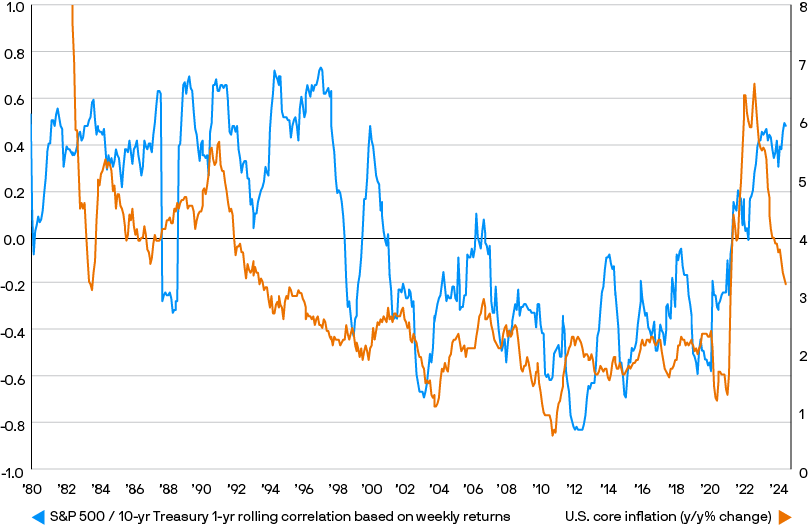
Source: BLS, LSEG Datastream, S&P Global, J.P. Morgan Asset Management; data as of August 19, 2024. Past performance is not a reliable indicator of current and future results.
Download this year's Long Term Capital Market Assumptions report
